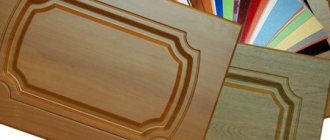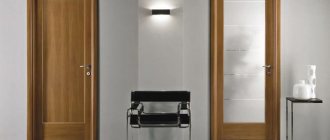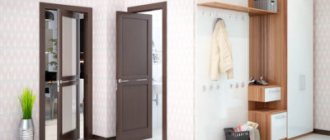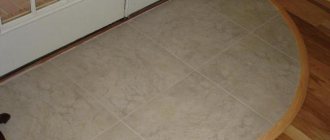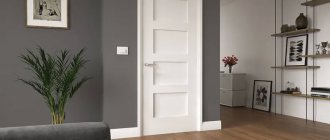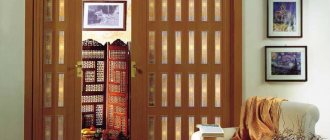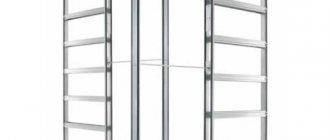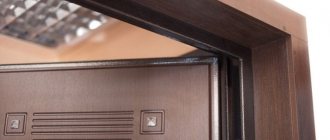During a major renovation of a house or apartment, everything needs to be changed, including interior doors. They are one of the main decorative elements, capable of decorating the interior and creating home comfort. Only a high-quality interior door can have good performance characteristics, and in addition, their appearance must be combined with the overall style of the living space.
Doors last quite a long time, about 10-15 years, so you need to choose them correctly so that they function reliably all this time, are comfortable and beautiful, and most importantly, have good quality. When choosing doors, many people are concerned about the question of which models are better, with PVC or veneer . To answer this question, you need to know all the characteristics of both types and then go shopping.
What are interior doors made of eco-veneer?
Eco-veneer is a polypropylene film with wood-like decor. “Eco” in this case means that the material is environmentally friendly, and not that it is of natural origin, as many might think. But that’s exactly what we’re counting on.
By combining two meanings in one word, marketers have outdone themselves. Veneer is a natural cut of wood, and in addition it is also “Eco”. What could be cooler? But we repeat, this is just a polypropylene film, and nothing more.
Sliding doors coated with eco-veneer in wenge color
Why the emphasis on sustainability? Because before this, mainly PVC film, which contains chlorine, was used in the cladding. True, this chlorine is there in a bound state and this coating is also absolutely safe. But it turned out to be a good legend for introducing new material to the market.
Doors made of eco-veneer are mostly prefabricated or, as they say now, “tsar doors.” This means that they are assembled from different parts: frame (frame), filling parts and glass. Everything is covered with eco-veneer before assembly. Each detail of the future door leaf is wrapped in film so that the edges can be tucked into the seams when assembled.
This design has several advantages:
- Firstly, there are no edges at the ends of the canvas, because the racks are wrapped in eco-veneer 360 degrees.
- Secondly, the frame parts are not glued together, but assembled using ties. If everything is done efficiently, then there is a hypothetical opportunity to disassemble the door leaf and replace the damaged part. In modern realities, when practically nothing is repaired, this is not bad.
Eco-veneer door to the bedroom
What can you say about the eco-veneer itself? These are very high-quality films, with a relief that truly conveys the texture of wood in appearance and touch. The film itself should be quite thick, and therefore durable. She must endure blows, pokes with sharp and hard objects, and attempts to scratch her without leaving a trace.
Why do we say "should"? Because, as always happens, when something good and high quality appears, fakes appear. And in our market, everything is now called eco-veneer, so you don’t need to take its word for it, check it yourself. When you examine a sample, you must definitely find the place where you can evaluate the coating - its cut or edge. The easiest way to do this is on the trim, frame or on the upper end of the door leaf, which always remains untreated.
What to watch:
- Firstly, the film should be a diaper, not paper. The film does not tear. She is thick and strong.
- Secondly, you need to evaluate how the eco-veneer adheres to the base and how it is glued.
- And of course, you need to evaluate the drawing itself. After all, the decor is the most difficult part to produce. Manufacturers of decorative films compete to see who can bring the most beautiful and fashionable coating to the market. It is the decor that determines the cost of the film. And here, as usual, there are companies that make advanced products. And there are fakes whose decor is a copy of the original, and sometimes it’s not of very high quality. When you go through a lot of samples, for example, in the process of renovating an apartment, you begin to figure it out a little, and you realize what’s cool and what’s not. Door manufacturers also want to reduce costs and buy cheap films, so figure it out and buy the first one you come across.
Bathroom door coated with eco-veneer
Main differences
- Price Veneered products are more expensive than laminated ones because they are of better quality. At the same time, high-quality interior doors using laminate are not much cheaper than veneered ones.
- Installation location Laminated panels are more suitable for rooms with high humidity and rooms that receive a lot of sunlight.
- Design This point is taken into account for each customer individually. Some people love the natural appearance that veneer has, while others choose artificial (laminate).
- Resistance to mechanical stress Veneer is more resistant than laminate. If there is damage, the first version of the doors can be restored, but the second cannot.
All the points described will help when making a decision in choosing doors. Before you buy the product you are interested in, you need to consider which characteristics are most suitable for you. Then the chances of purchasing a product that will last for many years will increase significantly.
What are PVC coated doors and what is better PVC or eco-veneer
Doors with PVC coating are doors covered with PVC film, everything is logical here. If you show anyone, even a door specialist, two pieces (rolls) of film, one PVC, the other polypropylene (eco-veneer), then no one will find the differences. They may even have exactly the same decor.
The horror story about chlorine in PVC film probably hasn’t scared anyone for a long time, because... Everyone understands that chlorine is bound there at the molecular level and can only be released during combustion. And the most harmful substances, in both films, are used specifically for applying decor. Therefore, there are no visual or tactile differences.
But there are differences in properties and this is why the doors are different.
Door coated with glossy PVC film
PVC film stretches under the influence of temperature and pressure, so it is applied to the doors using a thermal vacuum press . The film is heated and imprinted into the MDF base, covering all the relief decorative elements of the door leaf and moldings.
Eco-veneer (polypropylene film) does not stretch, and it is impossible to cover anything with a voluminous relief. It is thanks to these properties that PVC coating can imitate enamel, the now fashionable “Concrete” or SoftTouch, even leather. Doors can be made with real three-dimensional panels, with decorative elements, with carvings.
This allows you to make doors finished with PVC film much more interesting in design than those made of eco-veneer. Not everyone is interested in wood flooring when there are many other options. This is why doors with PVC coating remain leaders among film doors.
Three-panel door with carved platbands in PVC finish
You probably have a question: why do manufacturers use polypropylene film at all? The fact is that it is applied to the doors using other equipment, this allows you to reduce the price of the final product.
As for purely household properties or testing in a store, everything said about eco-veneer is also true for PVC film.
Tsar door in PVC film
This material was prepared jointly with the employees of the interior doors store “V Dom”. The photographs of the doors taken by the craftsmen after installation were especially useful. But this is only a small part of what is presented on the store’s website. Therefore, if you need to choose interior doors, follow the link, there you will definitely find the required options.
Manufacturing technology
If you compare PVC or veneer doors, in order to understand which is better, you should first understand the features of their manufacture. PVC and veneer are only the top layer covering the base of the canvas. Today they mainly use MDF. This can be a solid fragment or a lighter version - two thin sheets connected to each other by contour strips and internal stiffeners. The inside of such doors is filled with corrugated cardboard with a cellular structure like a honeycomb.
The coating itself is applied to the canvas by pressing. The PVC film is heated and pressed against the canvas in a vacuum environment, hugging every protrusion on its surface. The veneer is also attached using the hot pressing method. Varnish is applied on top to give the surface a finished look, shine and protect the material from damage and moisture. The edges of the door are closed with special strips to prevent dirt and moisture from getting inside.
What is veneer and veneered doors
Natural veneer is a thin cut of wood. In the door industry, veneers with a thickness of less than 1 mm are used. Veneer sheets are sewn into shirts, selected according to the pattern, and under enormous pressure they are literally pressed into an MDF base so that they become one.
Interior doors in oak veneer
Many believe that all this was invented only to make the final product cheaper, due to the fact that much less valuable wood is used. In fact, not only for this.
Veneer allows the surface of any complex product consisting of several parts to be made uniform, as if it were carved from one large piece of wood. Moreover, you can, for example, choose a pattern so that the largest stains fall exactly in the center of the desired fragment of the door leaf or are located symmetrically on it.
That is why ancient craftsmen used veneer. Veneering technology allows you to make very beautiful products.
Door in American walnut veneer
Previously, veneer was glued directly onto the solid wood; now the base is made more stable and inexpensive. The frame of the door leaf is assembled from solid pine, sometimes reinforced with high-strength timber made of laminated plywood. Then all this is covered on the outside with a layer of MDF, which serves as the basis for the veneer.
The panels are made from MDF board. This design turns out to be very durable, and most importantly with stable dimensions that will not change much (like solid wood) when the temperature and humidity in the apartment or house changes. I can't think of a better base for veneer.
Door covered with natural walnut with milling on the surface and glass
Veneer can be natural, usually from valuable species while preserving the natural wood pattern inherent in the species, and FineLine veneer, which is made from fast-growing species such as poplar and aspen. The peculiarity of the latter is that it is first cut into sheets, then glued and cut again.
In this way, an ordered structure is obtained, the thickness of the strips in which is regulated by the thickness of the initial cutting. This type of veneer is much cheaper than natural veneer and does not have a pattern of annual rings. But nevertheless, it looks modern and it is clear that it is natural wood.
Door in mahogany veneer
Tree
Our ancestors used natural wood to make furniture, doors and shutters. And now there are many fans of this natural material. Of course, wood products:
- environmentally friendly;
- durable;
- and very attractive.
They have a special energy and give the room an atmosphere of warmth and comfort. But wood also has its drawbacks:
- under conditions of changes in humidity and temperature, wooden products can shrink and crack;
- or vice versa, having accumulated excess moisture, it can become deformed and even rot;
- wooden products are quite flammable and not at all cheap material;
- the high price of products made from solid wood can probably be considered its biggest drawback. After all, if you install high-quality wooden panels as all interior doors, this will result in a fairly large sum.
Therefore, the modern market presents several more affordable and reliable options for door designs - made of veneer and covered with PVC film.
Which doors are better veneered or film eco-veneer, PVC
Veneer or eco-veneer, now the choice often sounds like this. We have already talked about the advantages of ecopon, how durable it is, how well it conveys the appearance of natural wood and the price is not high. And against this background, sellers, selling their doors, often begin to offend products made from natural veneer, such as expensive, fragile, afraid of moisture, scratched, everything will fall apart, etc. We don't agree with this.
Yes, eco-veneer is cheaper and maybe better able to withstand impacts and scratches, but that’s all. The main advantage of natural veneer is that doors made from it actually look better, they are natural, this can be seen immediately, many cannot be distinguished from the most expensive doors made of solid oak or ash. No matter how high-quality the film material is, in any case it is clear that it is a fake wood, and not the wood itself.
Door with gray eco-veneer for flooring
Further down the list. Are veneer doors afraid of moisture? In the previous paragraph, we did not specifically talk about what is used to cover the veneer on finished products. It is tinted to the desired shades and covered with protective compounds, varnishes of various types, which, by the way, are no worse in strength than films.
Veneer is painted, and paint is also an excellent barrier to moisture. All this is done with already assembled doors, i.e. cover them entirely, without seams or gaps. Therefore, the surface of the door leaf is protected no worse than that of eco-veneer.
Veneered door in the bathroom
If you imagine that the doors are installed in a small bathroom, where condensation periodically flows over all surfaces, then the situation is the same for veneer and eco-veneer. All untreated areas of the door block will be the first to take the blow: the upper and lower ends of the door leaf, the cuts and reverse sides of the trim, frames and extensions.
And in this case, this is where problems can begin: MDF will begin to absorb moisture, swell, and accordingly the coating in this place will begin to peel off (any coating, no matter veneer or eco-veneer).
To protect against this, you need to thoroughly coat all these places with varnish before installation. Also, it is better to lubricate the insertion points of the fittings (handles, locks, screws, hinges) before installing them.
Exposed door in the bathroom
Now about strength and unsticking. As we have already said, when veneer is applied, it is so firmly connected to the base that it literally becomes one with the frame, if, of course, everything is done well. Therefore, even with very strong mechanical damage, this sandwich behaves as one whole.
Even if a whole piece of material is torn out of the surface by something heavy and sharp, the veneer will not continue to peel off (as happens with a film coating), but will behave more like natural wood. Therefore, such damage on veneered doors can be restored, for example, with mastic in the color of the coating, which cannot be said about film doors.
Sliding door with large mirror in wenge veneer
Another advantage of veneered doors is their heavier and more durable construction . Because veneered doors themselves are more expensive than eco-veneered ones, but manufacturers make the door leaf and moldings of higher quality, more durable, without voids and honeycomb filler. This point must also be taken into account when comparing, and not just the beauty of the coating.
But veneer has one unexpected drawback: it fades in the sun, which is the price to pay for naturalness.
What to look for when choosing
If you decide to purchase laminated doors, approach this issue with the utmost care.
First of all, you should pay attention to:
- Base material. If chipboard is used, such a door is unlikely to last long; the best option is thin MDF with honeycomb filling.
- Type of coverage. Specify what type of film is used: paper, PVC, melamine, etc.
- Quality of gluing. On volumetric parts, as well as on the canvas as a whole, there should be no peeling or swelling.
- Edge. The most common defect is delamination of the edge or damage to the ends of the door.
If the door meets the quality standards in all respects, you can safely buy such a product. Do not forget to check with the seller about the composition of the coating to prevent toxic emissions at high temperatures.
Interior doors play a big role in creating the interior of an apartment. Today, consumers are provided with a wide choice of models, as well as the materials from which doors are made.
What solid wood doors are made from and which ones are better?
Wooden doors are made from different species, but in our material we will consider the most popular ones: pine, birch, alder, beech, ash, oak. They should be in the same order by increasing cost.
Pine is the most inexpensive (a normal door costs from 7,000 rubles per panel) and the most unusual in its properties. Due to its low density, it has very low thermal conductivity (this means it holds heat well, and indirectly good sound insulation).
Due to its natural resin content, it resists the influence of high humidity. Considering these two properties, it is clear why pine doors can be found in bathhouses and steam rooms, even in their untreated form.
Door made of solid pine with white wax coating
This same resinousness plays against manufacturers of pine doors when they need to make a high-quality coated product for an apartment or house. Drying pine takes a long time and correctly. If you don’t dry it completely or are simply unlucky, the finished product will crack or yellow spots will appear on the coating. Therefore, when buying pine doors, pay attention to the reputation of the manufacturer.
Pine has a beautiful, pronounced natural pattern, but the surface is very soft, so over time marks appear on the doors. Pine is usually covered with translucent coatings. Thick enamel is rarely used, because cracks may appear.
Next on our list are birch and alder. Purely in terms of consumer properties, they are somewhat similar. And the doors made of them cost approximately the same, from 12,000 rubles per leaf. The surface of birch and alder is slightly harder than that of pine, so these doors retain their ideal appearance longer, and they are not prone to cracking. Their wood is denser, so their insulating properties are worse than pine.
Solid alder door with walnut patina
These rocks are perfectly processed and polished to perfectly smooth surfaces. Once dried they are very stable, but do not like water. Therefore, doors made of birch and alder, unlike pine, are often covered with dense compounds and painted with enamels. They do not have a pronounced natural pattern; the pattern of growth rings is almost invisible. Birch without coating is milky white, alder is slightly pinkish. After tinting, the surface turns out calm and noble.
The same can be said about the appearance and finish of beech, only it is much stronger and harder. Beech door leaf can be purchased from 18,000 rubles.
Well, oak and ash combine all the advantages: a very beautiful bright pattern, the wood is strong, hard, perfectly processed and then does not throw up surprises, like pine. Therefore, these doors are the most expensive, starting from 22,000 rubles per door leaf. In oak and ash, the design is usually not painted over, but rather made even brighter and more expressive. Various techniques are used for this: two-color tinting, etching, brushing, etc.
Solid ash door with beautifully selected slats
You can distinguish oak from ash by their core rays; ash does not have them . Ash is not suitable, unlike oak, for the manufacture of external doors, because the environment has a negative impact on him. Oak entrance doors, on the contrary, are very popular.
Which ones to choose
Which doors are still better to choose: veneered or PVC? It is worth considering this issue based on the style of the room and its purpose, as well as available finances. Depending on what materials are used in interior design, one or another product may be more appropriate.
Veneer fits perfectly into classic style, loft, country, and some modern trends. Film, especially in bright colors, will be more appropriate in youth ultra-modern interiors, for example, pop art, fusion, hi-tech or modern. For the kitchen and bathroom it is worth buying moisture-resistant PVC doors. Although, if veneer or natural wood is used for the kitchen set, you can supplement this composition with the same material. In addition, thanks to several layers of varnish, veneer is also able to withstand the difficult conditions of the kitchen.
As for the price range, in general PVC coating is cheaper, but sometimes veneer is not much more expensive. Then you should decide based on your own preferences. Much depends on the country of manufacture of the products and the reputation of the company. Both materials deserve attention, so be sure to consider each of them and only then make your final decision.
What is better than pine doors or eco-veneer and PVC?
We compare exactly these segments, because their prices are comparable. In general, this is similar to comparing an artificial bouquet with a living one.
Pine doors exude their naturalness; they even smell like pine needles. Yes, their surface may not be ideal, marks from all impacts accumulate on it, cracks appear, but this does not make them worse. After all, this is a real tree, with a beautiful pattern that is not repeated on neighboring doors, with character and its own charm.
In addition, when you close them, you feel that the doors are entirely made of wood , and the natural properties of pine give them excellent insulating properties.
Door finished with snow-white PVC film
All this is not present in film doors, but there is only an impeccable appearance, like a carbon copy, repeated from canvas to canvas. And also the surface, which is like a plastic bouquet, will never wither.
Gloss finish
A coating such as gloss has become one of the most popular trends in interior design, in particular for the design of doors. It is at the same time laconic, stylish and quite durable, so it is equally suitable for use in everyday life or commercial real estate (offices, restaurants). For their production, various materials are used: from MDF to natural wood. The frame is the base raw material, which is varnished.
Advantages and disadvantages
The advantages of the material include:
- a good selection of names suitable for any style;
- versatility - glossy shine adds high value to the interior, harmonizing well with any type of floor and wall decoration;
- ease of care, not requiring the use of specialized chemicals;
- strength, resistance to external influences, which guarantees durability;
- the multi-layer coating does not allow moisture to seep through, thanks to which such interior doors are protected from mold growth;
- high rates of sound and heat insulation;
- the reflective surface visually makes the room a little larger.
But, despite the good operational parameters, such configurations also have disadvantages. The key is the need to constantly monitor their cleanliness. A shiny coating often leaves stains, fingerprints and other contaminants that immediately spoil its appearance. If these are black doors, then dust will be clearly visible on them. Therefore, in order for glossy doors to always have an impeccable appearance, they need to be constantly monitored. Some buyers refuse such solutions due to the complexity of their integration into the interior.
Interesting fact. The most popular shades of glossy interior doors are black and white. White harmonizes perfectly with dark floors. Black doors will attract maximum attention, so they can be a key accent in the interior.
What is better: veneered doors or solid wood
The veneer is wood, and inside the frame is made of coniferous species. In general, I would determine the point of transition from purely solid doors to veneered ones by adding MDF to the design.
Veneer is also used in 100% solid doors. For example, to make the surface more expensive and beautiful. For example, an inexpensive oak door is made of small blocks glued together, and its surface looks like stacked parquet. To turn a surface sewn from pieces, like Frankenstein, into one whole, lamellas or veneer sheets appear on it, which differ only in thickness.
There are other options, for example, solid pine inside, and a harder solid alder outside. Or the frame of a paneled door is made of solid birch, and the panels are made of solid pine with a beautiful pattern. There are a lot of options, and breeds have always been combined.
Double-leaf door in ash veneer, painted according to RAL catalog
Well, one day it dawned on people, why use natural wood everywhere? After all, you want to change some properties of the door leaf for the better, for example, its price, weight, consistency of geometry, susceptibility to fluctuations in humidity. And with the advent of new materials this became possible. MDF is just such a material that contains only natural components, is cheap, durable, and holds its dimensions perfectly.
We get a frame made of pine, then a layer of MDF as a backing for veneer, and on the surface a layer of expensive, beautiful, natural wood. At the same time, the door turns out to be 2.5 times cheaper than if it were made entirely of this wood, and this is in the most economical version. Well, what can I say, it's up to you to decide!
3.7 Total Score
Customer ratings: 3.67 (3 votes)
How good are laminate doors?
Laminated doors are a wood frame lined with paper film. The coating can imitate any type of wood, color of stone or texture of plaster. Suitable for painting in any color and for custom decor.
Laminated doors can last 5-10 years, but are not very resistant to damage
Advice. A laminated door is not suitable for high traffic areas, such as an office. The optimal installation location is a residential building or apartment.
Advantages of laminated construction:
- Price-quality ratio. These canvases can be purchased at an affordable price, and they can last up to 5-10 years.
- Doors of the same series are similar, like twin brothers. This means that if six months later you decide to buy exactly the same door, this is quite possible.
- Light weight of the canvas, which is important for interior partitions that are not designed for heavy structures.
Disadvantages of using laminated doors:
- Reduced strength threshold in comparison with veneered options. Scratches and abrasions may appear on the canvas.
- The coating of a low-quality copy may be glued in violation of the technology and will peel off over time.
- If the laminate is applied to a paper base and not to MDF, then the canvas will not withstand humidity.
There is another coating option - laminate, this is the same laminate, which is more durable. Its base is multi-layer pressed paper, similar to plastic. Compared to plastic, the coating is less durable, but more environmentally friendly.
Advantages of natural veneer
- environmental friendliness
- cost (depending on the type and method of production, budget and status option)
- impact strength
- additional sound insulation
- wide range of applications, not limited to interior and entrance doors
- with the use of protective mixtures, liquids and varnishes, the impact of the environment is reduced (durability increases)
Eco-veneer, with imitation of valuable varieties, will cost much less than the original veneer, will not require additional care and will last a long time. Natural veneer produced using the fine-line method will also be cheaper than peeled and sliced veneer. And treated with special compounds will be no less durable.
There are a huge variety of veneers and eco-veneers on the building materials market. Which successfully compete and replace each other. When choosing, you should pay attention to the manufacturer, the declared quality of the materials and environmental friendliness. There is no clear answer to the question of which is better. The choice is yours! We can provide recommendations on the general selection of interior doors.
Source: kvartirnyj-remont.com
Advantages of eco-veneer
The essential qualities of eco-veneer include:
- moisture resistance and non-hygroscopic
- mechanical strength (no chips, cracks, abrasions, dents, etc., due to use and rough handling)
- non-flammability
- low cost
- does not require additional care
- full imitation veneer
- solid resistance to external weather conditions
- Eco-veneer can be glued onto the prepared surface of the door without the use of machines. Since it is made of elastic and durable material
- huge selection of colors, textures and shapes
Types of veneer
Veneer differs according to the manufacturing method:
- peeled (when rotating a steamed log, a thin strip is cut parallel to the grain)
- planed (logs are sawn into bars and the strip is cut perpendicular to the grain)
- sawn (the method of cutting into planks is used, exclusively varieties of coniferous trees)
- fine-line (combined painting, gluing, pressing, cutting to reproduce the texture of valuable species)
By appearance:
- natural (non-painted veneer with natural texture)
- colored (color change with dyes)
